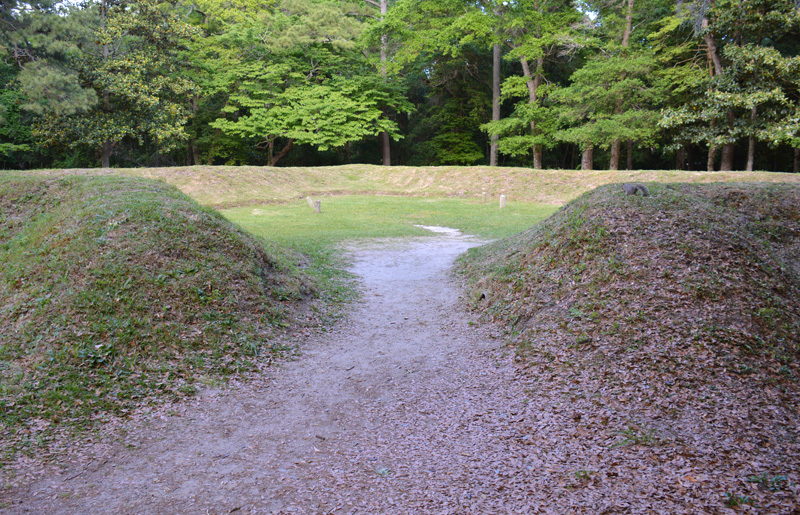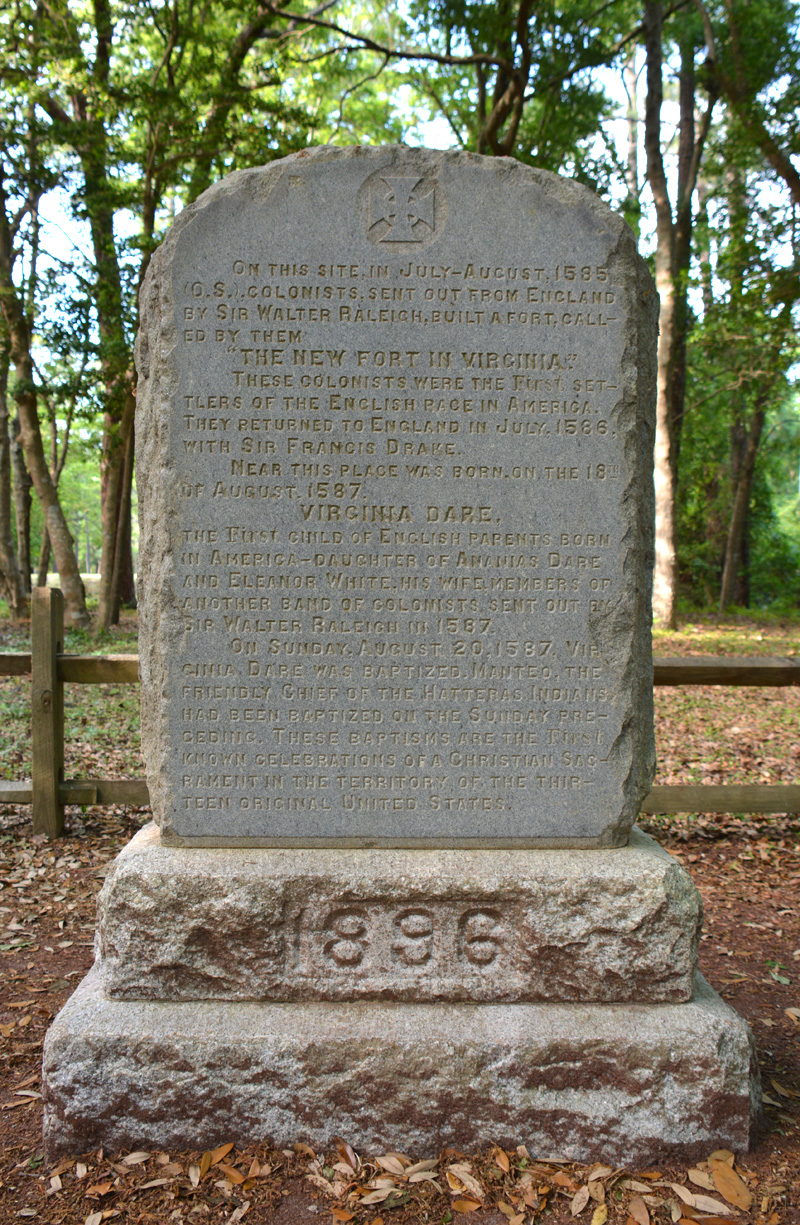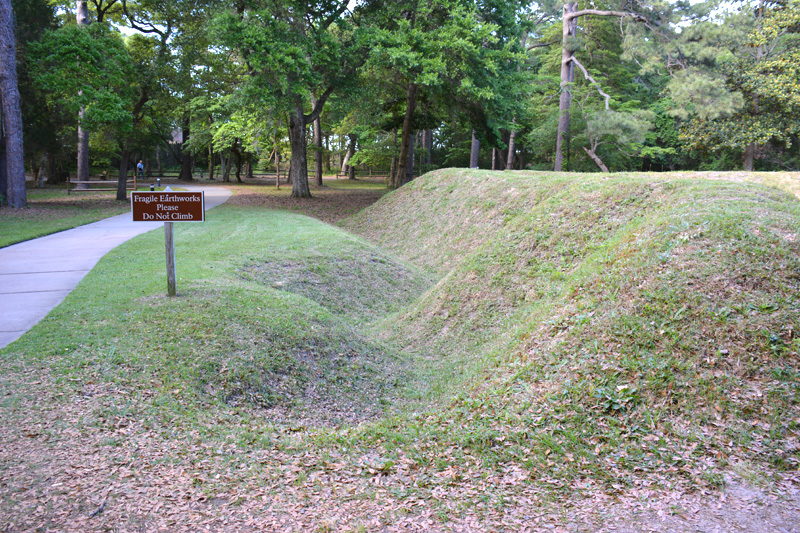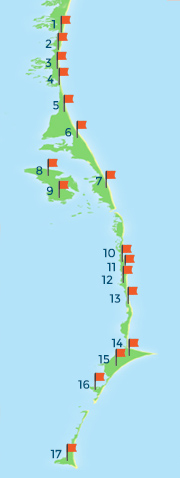- Manteo
- 252-473-5772
- Map it
Looking at the small town of Manteo, with its Crepe Myrtle lined busy main streets, and charming downtown filled with contemporary restaurants and old antique stores, one wouldn't necessarily think that this Outer Banks village was the veritable birthplace of European Settlement in America.
However, a trip to Fort Raleigh National Historic Site will certainly clear up this misconception, from the extensive Visitors Center filled with artifacts that were excavated on site, to the nearby grassy mound indicating the "resting place" of the original 1580s fort. The area, which is managed by the National Park Service, has been identified as the original site of the doomed Lost Colonists, who disappeared off the face of the earth over 400 years ago, and whose fate still remains a mystery to historians and archeologists from around the world.

A visit to the Fort Raleigh National Historic Site is, essentially, a step back in time and a front-row seat to one of American history's most enduring mysteries. Whether you take in the famed Lost Colony outdoor show at the Waterside Park, or visit the Queen's Rose Garden and period statues at the Elizabethan Gardens, (also located within the site), you're sure to uncover an incredibly unique slice of the Outer Bank's rich and tumultuous past.
History of the Fort Raleigh National Historic Site
In the late 1500s, under the reign of Elizabeth I, the English began exploring the "New World" under the command of Sir Walter Raleigh. Spanish explorers had already discovered and colonized a large chunk of present day South America and the West Indies, so the English set their sights on the North American coastline, where relatively few Spanish ships had settled or explored.
The first English explorers to ever set foot on the American coast landed in North Carolina in 1584. The two explorers, Philip Amadas and Arthur Barlowe, were excited by what they found, and they reported back to Sir Walter Raleigh that the area of what is now modern day Roanoke Island, with its estuaries, fresh water ponds, and dense forests, was ideal for a settlement.

Raleigh sent a settlement party of 100 Englishmen to Roanoke Island the following year, but this initial expedition was a disaster from the start. Landing at the end of fall with no time to plant crops, and raising the suspicions and ire of the local Native American tribes, this first group of colonists left just a year later, hopping a ride back to England with Sir Francis Drake who had stopped by to see how the settlement was progressing.
Instead of being deterred or considering this a bad omen, Raleigh tried again, and in 1587 he sent 117 men, women and children back to Roanoke Island under the command of the new settlement's governor, Captain John White. White's own pregnant daughter, Eleanor Dare, was part of the new settlement party, as was her husband, Annanias Dare.
The tension with the local Native Americans from the previous settlement was still high, and White was nervous about returning back to Roanoke Island. Soon after their arrival on August 18, 1587, Eleanor Dare gave birth to a daughter she named Virginia, who would earn the designation of being the first English child born in America.
Also not long after the camp arrived, White realized they were already low on supplies and he hesitantly left the settlement, including his daughter and new grandchild, to return to England with the intention to restock and quickly return.
White arrived in England safely, but he found himself trapped by the ongoing war with Spain and the invasion of the Spanish Armada. Paperwork and politics would delay his return even further, and it wasn't until August of 1590 that White was finally able to return to Roanoke Island.
What White discovered when he landed was shocking. The entire colony had been deserted, with homes, forts and fencing still standing, but not a single living soul in sight. The only clue to the Colony's fate were two words carved into two neighboring trees: "CRO" and "CROATAN."

White believed, (as do many modern historians), that this was a cryptic indication that the settlement had moved south, to Hatteras Island where the friendly Croatan Native Americans resided. Unfortunately, after a long and extensive canvas of the southern shoreline, White found no sign of the settlement, and the Lost Colony was never heard from again.
For over 400 years, historians have been baffled by the fate of the settlers of The Lost Colony. Were they destroyed by the neighboring Indians? Was there a plague or widespread starvation? Or did they simply move south, to Hatteras Island? While the answers to these questions have never been uncovered, one incredible Lost Colony discovery in Roanoke Island was eventually unearthed - the original site of the settlement's "Fort Raleigh."
A large grassy lump within the Fort Raleigh National Historic Site was always referred to by 1800s and 1900s locals as "Fort Raleigh," but it wasn't until intensive excavations in the later 1930s and 1940s that this designation could be deemed true.
The original fort was an "earthen fort," meaning that it was comprised primarily of wood and lots of lots of mud. As a result, it deteriorated over the centuries and sunk into the ground, leaving only a squat above-the-surface mound to indicate it ever existed. The 1940s archeological digs unearthed a number of treasures from the original site, lending credence to the theory that this was, in fact, the fort from the original Lost Colony. Items recovered included an Indian pipe, an iron sickle, and metal counters, among other small treasures.
As a result of the discovery, the area was deemed a National Historical Site in 1941, and the Fort Raleigh National Historic Site became an attraction for both amateur and professional historians from all across the country. The earthen fort was "restored" in the 1950s, and visitors today can still see the large lumpy mound protruding from the ground - the last structural relic of the original Lost Colony.
The area would be a settlement once again, this time with much greater success, when it became the Freedmen's Colony in 1863, a self-sustaining colony of free African Americans. Though only in operation for a few brief years, the colony was a tremendous success, boasting 2,200 residents from all across the south. The residents either worked for the government, or within the colony itself as teachers, carpenters, fishermen, or other instrumental positions. By the time the camp was disbanded, (amidst property disputes from the government and the area's original landowners), the community had a sawmill, fisheries, and more than 600 cabins and homes. The colony is honored in with a marble monument that was erected at the Fort Raleigh National Historic Site in 2001, and their story and exhibits can be found at the neighboring Visitors Center.
Fort Raleigh National Historic Site Visitors Center
The Visitors Center is a sprawling, one-story building that welcomes guests as they enter the grounds of the site. Open year round from 9:00 a.m. - 5:00 p.m., (except on Christmas Day), the center provides an in-depth introduction to the history surrounding the site, from the original Lost Colonists to the new settlers of the Freedmen's Colony who settled on Roanoke Island 300 years later.
Inside the Visitors Center, guests can watch a 17-minute video recapping the story of the Lost Colony and the efforts by archeologists to unearth their history, or can simply peruse the exhibits, many of which are artifacts from the original settlements that were uncovered just yards away. Recent excavations beginning in 2008 have uncovered even more treasures, and the Visitors Center plans to install even more exhibits for visitors in 2013.
Completely free to the public, an initial stop at the Fort Raleigh National Historic Site Visitors Center will give modern-day Outer Banks explorers a quick overview of the site, well before they begin to walk around the grounds.
The Lost Colony Outdoor Drama
One of the most popular and longest running nighttime attractions on the Outer Banks is the Lost Colony outdoor drama, staged within the Fort Raleigh National Historic Site at the Waterside Theater.
Even outside of regular show times, the theater itself is an impressive site to behold - the wooden canopied stage is reminiscent of the English Theater Houses of the Elizabethan Era, though it is flanked by tall wooden pilings, and has the Roanoke Sound as a stunning waterfront backdrop. The combination of these two factors is certainly an indication of what an Elizabethan theater of the late 1500s would look like, had it been built in the New World.
The play itself has an exceptionally rich history all its own, dating back to the 4th of July, 1937, when the outdoor drama first opened. The idea for the drama sprung from a successful 1920s "pageant" which celebrated the Lost Colony, as well as Virginia Dare's upcoming 350th birthday. North Carolina playwright Paul Green revised the original script to include music, dance, and dialogue, and to tell the entire story of The Lost Colony from start to finish.
At the time, the nation was in the throes of the Great Depression, and public works projects were in full swing in national parks throughout the nation. As a result, Works Progress Administration (WPA) funds and Civilian Conservation Corps (CCC) laborers were used to construct a set, hire accomplished out-of-work Broadway actors, and produce an outstanding production that would impress the public.
And impress it did. Franklin D. Roosevelt, who saw the show just one month after it opened, remarked "We do not know the fate of Virginia Dare or the First Colony. We do know, however, that the story of America is largely a record of that spirit of adventure."
Since that 1937 opening night, over 1 million visitors have seen the show. Over the decades, tweaks and changes were made to the script to keep it fresh, and a number of famous actors have made their initial forays into the acting world on its stage. The most famous actor to perform in The Lost Colony was Manteo local Andy Griffith, however a number of other stars, including Leon Rippy, Chris Elliott, Terrence Mann and R.G. Armstrong all began their careers in Manteo. Even North Carolina Sen. Marc Basnight has ties to the show, as he played a colonist child as a young Manteo resident.
Today, visitors can still see the future stars shine at the open, outdoor theater. From Memorial Day to Labor Day, the nightly production welcomes visitors of all ages, and even allows special backstage and post-show "visits" with some of the cast members. Tickets are available online in advance, or at the Fort Raleigh National Historic Site. Reservations are recommended, as the country's longest running outdoor drama has always been popular with visitors and locals alike. Keep in mind that because of the open, outdoor stage, the Lost Colony is cancelled on rainy nights.
In addition to the summer Lost Colony production, the Waterside Theater is also host to a number of events throughout the year, including concerts, Shakespearean plays, musicals, and much more. Many of these events take place in the fall, winter and spring months, allowing even off-season visitors to enjoy a show at the spectacular waterfront setting. For more information on upcoming events at the Waterside Theater during your Outer Banks stay, visit the Lost Colony website.
The Elizabethan Gardens
The Elizabethan Gardens almost seem like a separate attraction from the Fort Raleigh National Historic Site. An impressive sight within the Site, the Elizabethan Gardens is well guarded by a Tudor-era brick entry complete with historical For Raleigh flags and plenty of gorgeous seasonal foliage.
With the exception of the Lost Colony Drama, the Elizabethan Gardens is the only section of the site that requires an entrance fee. That said, most all Outer Banks vacationers find the nominal fee well worth the experience, and avid gardeners and nature lovers make it a point to revisit the gardens years after year. Within the weathered brick walls, visitors will find acres of gorgeous roses, hydrangeas, camellias, crepe myrtles, bulb flowers, butterfly bushes, and an assortment of other seasonally exuberant flowers. Every season creates a new natural display, and mainstay attractions like the sunken garden or thatched gazebo along the soundfront can be enjoyed by visitors all year long.
Be prepared to spend several hours touring the small wooded paths that run through all areas of the gardens, and be sure and make a stop at the gift and plant store before you depart. Lovers of the Elizabethan era and vacationers with a green thumb will adore the extensive selection of locally grown native plants and Elizabethan inspired trinkets for sale.
The Elizabethan Gardens are open year-round, and visitors are advised to keep an eye out for special events, particularly around the holidays when the gardens host family-friendly celebrations which are designed to be fun for all ages. Planning an off-season visit? Then swing by for the harvest days, the Easter Eggstravaganza, or the incredible month-long Winter Lights, where the gardens are illuminated by hundreds of thousands of Christmas Lights throughout the grounds.
Nature Trails and Other Explorations
In addition to the historical attractions, the Lost Colony drama, and the Elizabethan Gardens, the Fort Raleigh National Historic Site is also a popular destination for nature lovers who enjoy exploring the site's well-manicured grounds and two nature trails.
The Thomas Harriot Nature Trail, which veers to the west of the main entrance and Visitors Center, offers a 20 minute stroll through the Roanoke Island wilderness, not unlike the terrain that the Lost Colonists first discovered when they came ashore over 400 years ago. Visitors will note small signs along the trail indicating certain sites, species, or plant life that the original colonists observed on their first expeditions, and how they put these resources to good use.
The Freedom Trail begins near the Elizabethan Gardens and extends through the park for 1.25 miles, bordering the island's western edge, and presenting a natural replica of the area that the original native Algonquins called home. Be on the lookout for peeks of the Roanoke Sound, almost hidden by 50' ft. pine trees and clusters of cedars and Live Oaks. This trail is popular with both historians who love to fully immerse themselves in a story, as well as local joggers and walkers in need of a well-manicured and scenic fitness trail.
Visitors should also feel free to explore the grounds in their entirety, from the small souvenir shop located outside the Waterside Theater to the extensive parcels of land adjacent to incredible sound sunsets. Fort Raleigh National Historic Site is an inviting locale for strollers, hikers, or waterfront picnickers, and everyone is welcome to freely explore and discover the area, just as the original colonists did.
The Fort Raleigh National Historic Site is an incredible attraction for historians, nature lovers, theater-goers, gardeners, and simple fans of the Outer Banks. As the area's oldest community, the towering pines and endless sound views help visitors discover why the area was such a draw to the original 1580s colonists, and the small remnants left behind, such as the Fort Raleigh mound or the artifacts carefully preserved in the Visitors Center, serve as a visible reminder of the OBX's role in American's earliest roots.
Take a day trip to Manteo, and explore the origins of American history. Before Jamestown and before Plymouth, there was tiny little Manteo, and the Outer Banks is proud to share its heritage, through gardens, performance art, museum-quality artifacts, or wild nature trails, with all contemporary visitors.
Is this your business? Update your listing by messaging us



